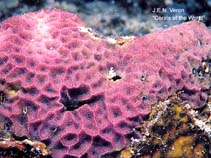Psammocora haimiana Milne-Edwards & Haime, 1851
Encrusting sandpaper coral
Classification / Names Common names | Synonyms | CoL | ITIS | WoRMS
Anthozoa | Scleractinia | Psammocoridae
Environment: milieu / climate zone / depth range / distribution range Ecology
Reef-associated; depth range 0 - 88 m (Ref. 98471). Tropical; 31°N - 34°S, 26°E - 137°W (Ref. 847)
Distribution Countries | FAO areas | Ecosystems | Occurrences | Introductions
Indo-Pacific: South Africa to Japan and French Polynesia.
Length at first maturity / Size / Weight / Age
Maturity: Lm ? range ? - ? cm
Short description Morphology
Colonies are submassive with corallites at the bottom of depressions or in short non-meandering valleys. Walls have acute tops with petaloid primary septo-costae, which are not exsert (Ref. 847). Color ranges from light blue-grey to reddish brown. Corallites are small and almost square in shape (Ref. 130769).
Maximum depth from Ref. 115142. Can be found in shallow waters (Ref. 122680), in shallow reef areas (Ref. 847); uncommon on subtidal reefs between 3 to 25 m depth (Ref. 88997). Inhabited by polychaete worms, which also serves as it distinguishing feature (Ref. 130769).
Life cycle and mating behavior Maturity | Reproduction | Spawning | Eggs | Fecundity | Larvae
Members of the class Anthozoa are either gonochoric or hermaphroditic. Mature gametes are shed into the coelenteron and spawned through the mouth. Life cycle: The zygote develops into a planktonic planula larva. Metamorphosis begins with early morphogenesis of tentacles, septa and pharynx before larval settlement on the aboral end.
Main reference
References | Coordinator | Collaborators
Veron, J.E.N. 2000. (Ref. 847)
IUCN Red List Status (Ref. 130435)
Least Concern (LC) ; Date assessed: 03 January 2008
CITES status (Ref. 108899)
Appendix II: International trade monitored
CMS (Ref. 116361)
Not Evaluated
Threat to humans
Human uses
| FishSource |
Tools
More information
Internet sources
BHL | BOLD Systems | CISTI | DiscoverLife | FAO(Publication : search) | Fishipedia | GenBank (genome, nucleotide) | GloBI | Gomexsi | Google Books | Google Scholar | Google | PubMed | Hexacorallians of the World | Tree of Life | Wikipedia (Go, Search) | Zoological Record
Estimates based on models
Preferred temperature
(Ref. 115969): 24.7 - 29.1, mean 28 (based on 1270 cells).
Price category
(Ref. 80766):
Unknown.



